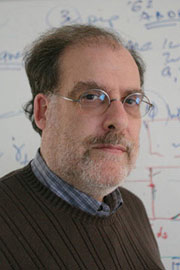

Friday - May 8, 2009
SLAC Today is
available online at:
http://today.slac.stanford.edu
In this issue:
From the Director of PPA:
The Unity of Particle Physics and Astrophysics
DOE 2010 Budget Request to Congress
Financial Overview Class
Word of the Week: Cosmic Ray
 |
 |
|
Friday - May 8, 2009 |
From the Director of PPA: The Unity of Particle Physics and Astrophysics I spent the early part of this week at the "April Meeting" of the American Physical Society (held in May this year and planned for February next year). The APS holds two annual meetings: The March Meeting covers condensed matter, atomic, molecular, and optical physics, and related fields, while the April Meeting covers particle physics, nuclear physics, astrophysics, gravitation and plasma physics. As such, the April Meeting is a good forum for presentation of PPA results, and SLAC was certainly well-represented at the conference. A particular highlight involved the presentation of new results from the Fermi Gamma-ray Space Telescope. Peter Michelson gave a plenary invited lecture last Saturday, which was extremely well-received, and I chaired a special Fermi session on Monday, in which Jim Chiang, also of the SLAC Fermi telescope team, was one of three invited speakers. The papers presented illustrated the wealth of new astrophysical discoveries that are emerging from Fermi. The Large Area Telescope, which was developed at SLAC as a cooperative effort between NASA, the Department of Energy and international partners, is performing flawlessly and discovering huge numbers of new gamma-ray sources of all varieties. However, the result that attracted the most interest was the measurement of the cosmic ray electron spectrum at high energies, up to 1 TeV. (See "High-energy Electrons Could Come from Pulsars—or Dark Matter.") Peter showed this for the first time during his plenary talk, and the details were discussed in a set of contributed papers from the team on Sunday and Monday. These results created a "buzz" during the entire four-day conference, and the sessions presenting them were "standing room only." Read more... DOE 2010 Budget Request to CongressThe Department of Energy has posted online its summary budget proposal documents and detailed budget justifications for the fiscal year 2010. They are available as PDF documents in the FY 2010 DOE Budget Request to Congress. Financial Overview ClassAny staff member with budgetary responsibilities is invited to attend a one-hour session on Financial Overview. This training is offered once a month. Charlotte Chang of Strategic Financial Planning will present the class on May 19, from 1:30 to 2:30 p.m. in the Yellow Room, Building 41. Please register on the Training Web site. Enter key search: FINOVR. Please contact Charlotte Chang (x2717) or Sylvia Rupilius (x4345) with questions. The cosmic ray detector in the SLAC Visitor's Center counts muons, one of the particles produced when a cosmic ray hits the
Earth's atmosphere. The detector uses three pairs of scintillator panels,
A, B and C. (Click image for more information.)
Word of the Week: Cosmic RayOnce thought to be electromagnetic radiation, cosmic rays are actually charged particles, mostly atomic nuclei, with energies typically higher than one billion electronvolts. About 89 percent are protons, or hydrogen nuclei, and 9 percent are helium, with nuclei of heavier elements and electrons each forming 1 percent. The highest energy ever recorded for a cosmic ray was 300 quintillion electronvolts; the tiny proton packed the energy of a hefty baseball thrown at 60 miles per hour. Every second, about 100 cosmic rays bombard every square meter of Earth's atmosphere and decay in cascading showers of subatomic particles. About a hundred of these secondary particles pass through our bodies every second. As charged particles, cosmic rays are rerouted by magnetic fields on their way to Earth, so scientists must use their neutral byproducts—usually photons or neutrinos—to trace their origins. Nearby pulsars are perhaps the most likely cause of the unusually large number of cosmic-ray electrons recently detected by the Fermi Gamma-ray Space Telescope, but dark matter is another possible explanation. |
Events (see all | submit)
Access (see all)Announcements
|
|
| | ||
|
|
||
 <%
Response.AddHeader "Last-modified", getArticleDate()
'Response.AddHeader "Last-modified","Mon, 01 Sep 1997 01:03:33 GMT"
'Monday, December 06, 2010
%>
<%
Response.AddHeader "Last-modified", getArticleDate()
'Response.AddHeader "Last-modified","Mon, 01 Sep 1997 01:03:33 GMT"
'Monday, December 06, 2010
%>View online at http://today.slac.stanford.edu/. |
||